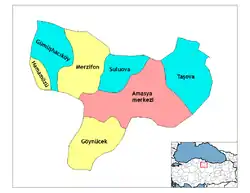Suluova
Suluova (Ancient Greek: Αργουμα, Argouma and Latin: Arguma) is a town and district of Amasya Province of Turkey, located on high ground inland within the central Black Sea region. It covers an area of 516km², and the population (2010) is 47,510 of which 37,669 live in the town of Suluova, the remainder spread throughout the surrounding countryside. Altitude is 510 m. The mayor is Fatih Üçok (AKP).
Suluova | |
|---|---|
 Suluova | |
| Coordinates: 40°50′N 35°39′E | |
| Country | |
| Province | Amasya |
| Government | |
| • Mayor | Fatih Üçok (AKP) |
| Area | |
| • District | 516.23 km2 (199.32 sq mi) |
| Population (2012)[2] | |
| • Urban | 37,155 |
| • District | 46,479 |
| • District density | 90/km2 (230/sq mi) |
Name
Suluova was known in antiquity as Arguma, meaning 'watery' and this was later translated into Turkish first as Suluca and later as Suluova, meaning watery plain. Two-thirds of the district lies on the plain (watered by the Tersakan River), one-third in the surrounding mountain forest. The land is dry and strong winds whip over the mountains from the Black Sea so Suluova is notorious for its dust storms. Özhan Öztürk claims that Argoma means "border settlement/base" at Hittite-Kaskians border[3] erha “border” + huma(ti) “base/settlement” while Bergama means "high settlement/base" in Hittite language[4]
Climate
Suluova has a warm-summer Mediterranean climate (Köppen: Csb).
| Climate data for Suluova | |||||||||||||
|---|---|---|---|---|---|---|---|---|---|---|---|---|---|
| Month | Jan | Feb | Mar | Apr | May | Jun | Jul | Aug | Sep | Oct | Nov | Dec | Year |
| Daily mean °C (°F) | 1.6 (34.9) |
3.3 (37.9) |
6.8 (44.2) |
11.8 (53.2) |
15.7 (60.3) |
19.1 (66.4) |
21.2 (70.2) |
21.3 (70.3) |
17.9 (64.2) |
13.3 (55.9) |
8.4 (47.1) |
3.9 (39.0) |
12.0 (53.6) |
| Average precipitation mm (inches) | 42 (1.7) |
31 (1.2) |
37 (1.5) |
50 (2.0) |
55 (2.2) |
44 (1.7) |
19 (0.7) |
12 (0.5) |
22 (0.9) |
33 (1.3) |
36 (1.4) |
45 (1.8) |
426 (16.9) |
| Source: Climate-Data.org[5] | |||||||||||||
History
Excavations of the hill of Kümbettepe show the history of Suluova goes back to 2000 BC, the stone age. The area was then settled by the Hittites.
The Seljuk Turks arrived in the 11th century AD and the area was brought within the Ottoman Empire in 1386.
Suluova today
Suluova has grown into a large town for four reasons: the area is a rich source of lignite coal, this is good farmland and in particular Turkey's largest growers of onions are located here, there is a sugar factory located there, and a railway line passes through the town.
Administrative structure
Towns
- Suluova
- Eraslan
Villages
- Alabedir
- Akören
- Armutlu
- Arucak
- Ayrancı
- Aşağıkarasu
- Bayırlı
- Boyalı
- Cürlü
- Çayüstü
- Çukurören
- Derebaşalan
- Dereköy
- Deveci
- Eğribük
- Harmanağılı
- Kanatpınar
- Kapancı
- Karaağaç
- Kazanlı
- Kerimoğlu
- Kolay
- Kulu
- Kurnaz
- Kutlu
- Kuzalan
- Küpeli
- Kılıçaslan
- Kıranbaşalan
- Ortayazı
- Oğulbağı
- Özalakadı
- Salucu
- Saygılı
- Seyfe
- Soku
- Uzunoba
- Yolpınar
- Yüzbeyi
References
- "Area of regions (including lakes), km²". Regional Statistics Database. Turkish Statistical Institute. 2002. Retrieved 2013-03-05.
- "Population of province/district centers and towns/villages by districts - 2012". Address Based Population Registration System (ABPRS) Database. Turkish Statistical Institute. Retrieved 2013-02-27.
- Hittite
- Özhan Öztürk.Pontus: Antik Çağ’dan Günümüze Karadeniz’in Etnik ve Siyasi Tarihi. Genesis Yayınları. Ankara, 2011 pp. 438-39
- "Climate:Suluova". Climate-Data.org. Retrieved 10 April 2014.
